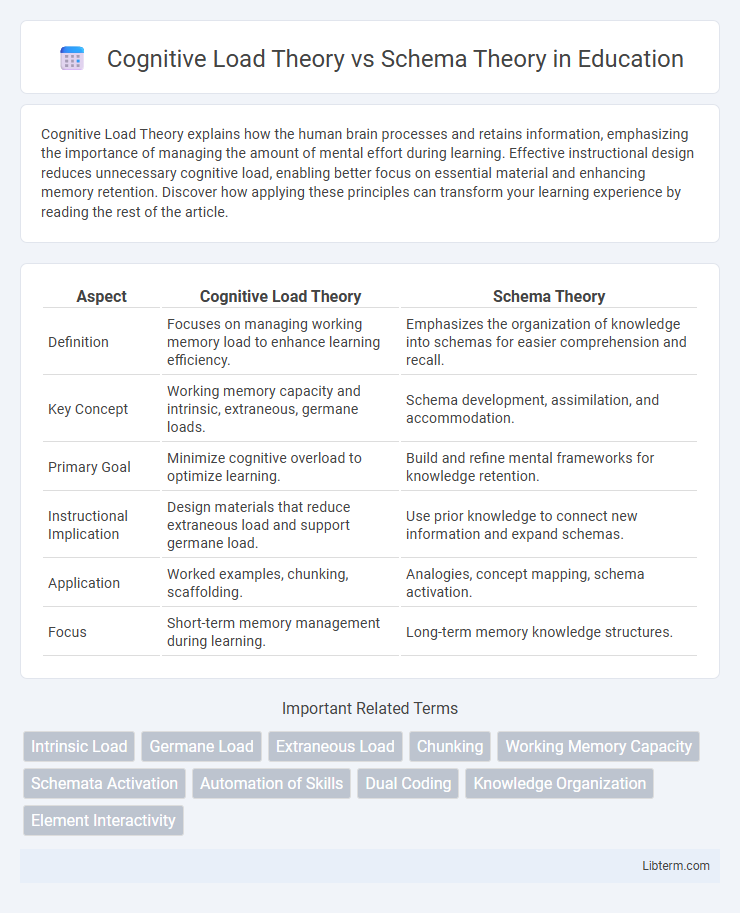Cognitive Load Theory explains how the human brain processes and retains information, emphasizing the importance of managing the amount of mental effort during learning. Effective instructional design reduces unnecessary cognitive load, enabling better focus on essential material and enhancing memory retention. Discover how applying these principles can transform your learning experience by reading the rest of the article.
Table of Comparison
| Aspect | Cognitive Load Theory | Schema Theory |
|---|---|---|
| Definition | Focuses on managing working memory load to enhance learning efficiency. | Emphasizes the organization of knowledge into schemas for easier comprehension and recall. |
| Key Concept | Working memory capacity and intrinsic, extraneous, germane loads. | Schema development, assimilation, and accommodation. |
| Primary Goal | Minimize cognitive overload to optimize learning. | Build and refine mental frameworks for knowledge retention. |
| Instructional Implication | Design materials that reduce extraneous load and support germane load. | Use prior knowledge to connect new information and expand schemas. |
| Application | Worked examples, chunking, scaffolding. | Analogies, concept mapping, schema activation. |
| Focus | Short-term memory management during learning. | Long-term memory knowledge structures. |
Introduction to Cognitive Load Theory
Cognitive Load Theory emphasizes the capacity limitations of working memory during the learning process, highlighting intrinsic, extraneous, and germane cognitive loads. It proposes instructional designs that minimize unnecessary cognitive load to enhance learning efficiency and knowledge retention. This theory contrasts with Schema Theory, which focuses on how information is organized in long-term memory through schemas and prior knowledge.
Understanding Schema Theory
Schema Theory explains how knowledge is organized into mental structures called schemas, which help individuals efficiently process and interpret information. This theory emphasizes that learning involves activating existing schemas to integrate new information, facilitating comprehension and problem-solving. Effective instructional design leverages Schema Theory by building on prior knowledge and organizing content to align with learners' cognitive frameworks.
Core Principles of Cognitive Load Theory
Cognitive Load Theory emphasizes the limitation of working memory capacity and categorizes cognitive load into intrinsic, extraneous, and germane types to optimize learning efficiency. It advocates designing instructional materials that reduce unnecessary cognitive load to enhance schema acquisition and automation. Schema Theory complements this by explaining how organized knowledge structures stored in long-term memory support information processing and expertise development.
Key Concepts in Schema Theory
Schema Theory centers on the idea that knowledge is organized into units called schemas, which are mental structures that help individuals interpret and process information efficiently. These schemas allow for quicker understanding by activating relevant prior knowledge when encountering new data, facilitating learning and memory retention. Key concepts include assimilation, where new information is integrated into existing schemas, and accommodation, which involves modifying schemas to incorporate new experiences.
Differences Between Cognitive Load Theory and Schema Theory
Cognitive Load Theory emphasizes managing working memory capacity to optimize learning by reducing extraneous load, while Schema Theory focuses on how knowledge is organized into mental structures called schemas. Cognitive Load Theory targets instructional design to prevent overload, contrasting with Schema Theory's explanation of how learners integrate new information into existing cognitive frameworks. These theories differ in their primary concerns: Cognitive Load Theory addresses memory processing limits, whereas Schema Theory centers on knowledge representation and retrieval.
How Cognitive Load Affects Learning and Memory
Cognitive Load Theory explains that excessive working memory demands hinder learning efficiency by overwhelming limited cognitive resources, whereas Schema Theory emphasizes the organization of knowledge into structured frameworks that reduce cognitive load. Effective learning occurs when instructional design minimizes extraneous cognitive load, allowing schemas to be developed and automated in long-term memory. As schemas become more complex, they enable faster retrieval and better integration of new information, enhancing both learning and memory retention.
Schema Formation and Knowledge Organization
Schema Theory emphasizes schema formation as the process where learners organize knowledge into structured units, enabling efficient retrieval and application of information. Cognitive Load Theory addresses the limitations of working memory during learning, suggesting instructional designs that reduce extraneous load to facilitate effective schema construction. Together, both theories highlight the importance of managing cognitive resources to optimize knowledge organization and long-term memory integration.
Practical Applications in Education and Instructional Design
Cognitive Load Theory emphasizes minimizing extraneous cognitive load through well-structured instructional materials to enhance working memory efficiency, particularly beneficial in novice learners' skill acquisition. Schema Theory supports the development of organized knowledge frameworks by activating prior knowledge and encouraging schema construction, thereby improving long-term retention and transfer of learning. Combining these theories in instructional design facilitates creating learner-centered environments that optimize cognitive resources while promoting meaningful understanding and expertise development.
Strengths and Limitations of Each Theory
Cognitive Load Theory excels at optimizing instructional design by managing working memory capacity to enhance learning efficiency but struggles with explaining complex knowledge structures beyond memory constraints. Schema Theory effectively describes how prior knowledge organizes new information into meaningful units, facilitating comprehension and problem-solving, yet it lacks precise guidance for instructional design and does not address cognitive processing limits. Both theories complement each other by balancing memory limitations and knowledge organization but require integration for comprehensive educational strategies.
Integrating Cognitive Load and Schema Theory for Effective Learning
Integrating Cognitive Load Theory and Schema Theory enhances effective learning by optimizing mental resources and promoting schema acquisition. Cognitive Load Theory emphasizes managing intrinsic, extraneous, and germane loads to prevent cognitive overload while Schema Theory focuses on building organized knowledge structures that facilitate information retrieval. Combining these approaches supports the development of efficient schemas through carefully designed instructional materials that reduce unnecessary load and enable learners to process and store information effectively.
Cognitive Load Theory Infographic

 libterm.com
libterm.com